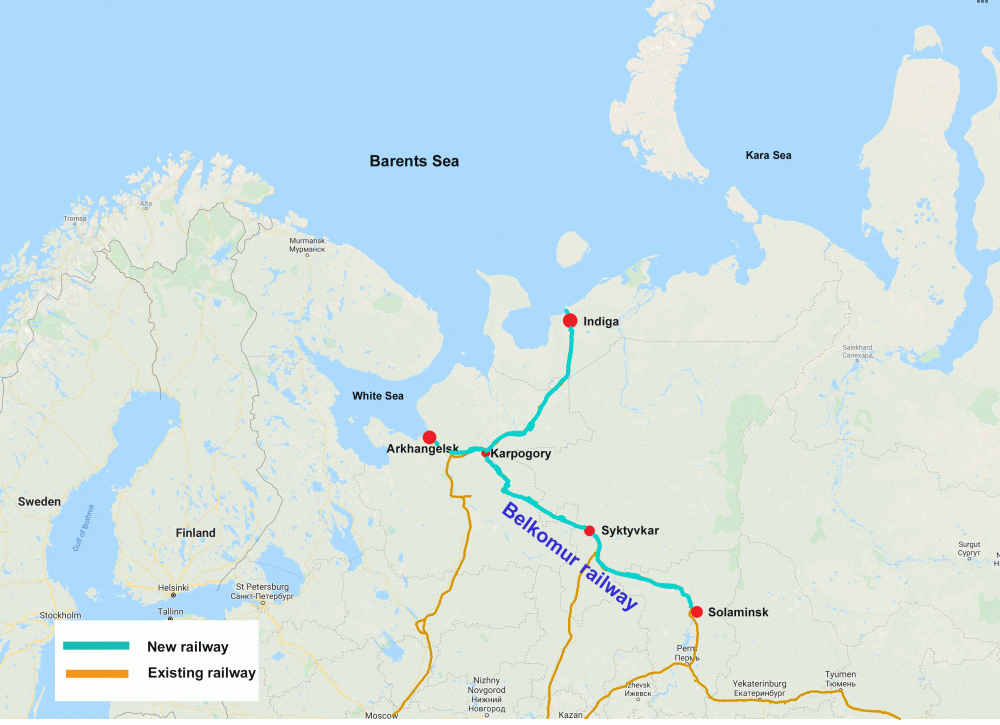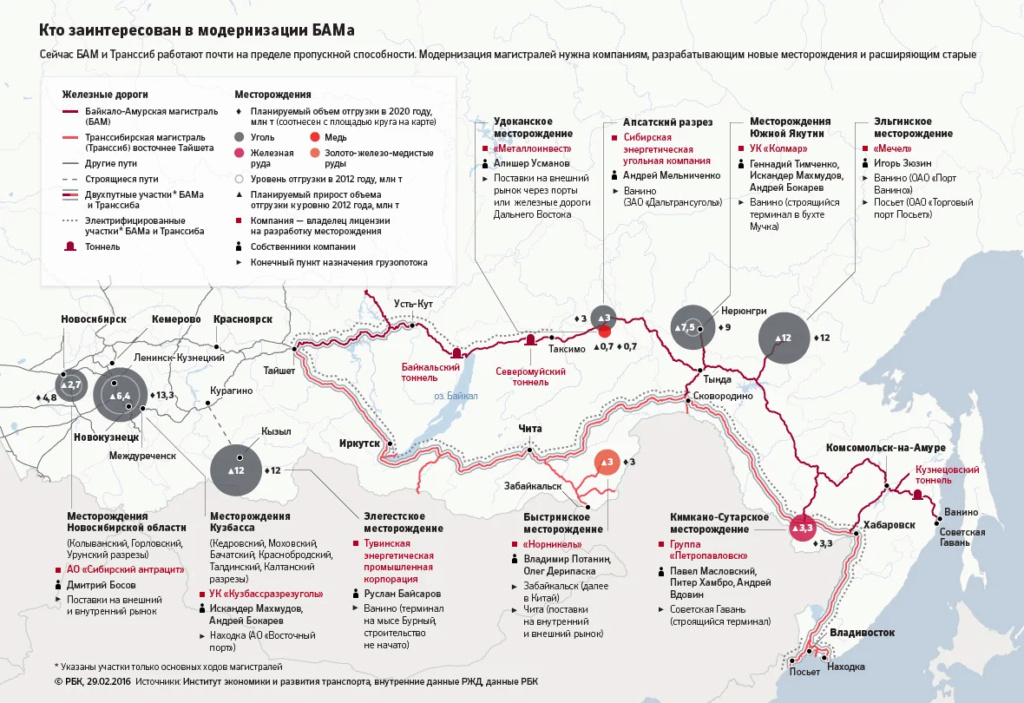A US opinion on the 'Northern Rail Route'.
Scrapped Railway Project Could Derail Putin’s Arctic Ambitions
By The Jamestown Foundation - Feb 23, 2023, 2:00 PM CST
Russian President Vladimir Putin has big plans for Arctic trade and development.
The Russian government has canceled a key railway project despite Putin’s repeated orders to the contrary.
The planned railway was a critical piece of infrastructure, and its cancelation could throw a wrench in Putin’s plans.
Moscow’s ability to develop its own resource-based economy, expand the Northern Sea Route, cement ties with China and support Vladimir Putin’s ambitions to project power into the Arctic depends on the development of land-based infrastructure in the northern regions of the Russian Federation (see EDM, April 29, 2016; September 11, 2018; December 6, 2018). Yet, that ability has now been called into question, as the Russian government has canceled, despite Putin’s repeated orders to the contrary, a program to complete the broad-gauge Northern Broad-Gauge Railway. The route was intended to link settlements that support the Northern Sea Route, military bases and the locations of key sources of raw materials across the Russian North with the rest of the country (see EDM, July 6, 2021; The Barents Observer, September 27, 2021; Ura.news, December 30, 2022, Svpressa.ru, February 19). Without such a rail line, in fact, Moscow will not be able to achieve its economic and geopolitical goals in the region, according to some Russian observers, as there simply are not enough alternative routes to support them (Ura.news, October 7, 2022; Regnum, August 30, 2022).
This planned railway is crucial due to the lack of other land-based infrastructure in the Russian North. At present, few regular highways exist in the region, and the melting of the permafrost makes constructing more roads extremely difficult, time-consuming and expensive (Profile.ru, December 22, 2022). The ice roads Russia has long relied on are now ever-more difficult to maintain and accessible for ever-fewer months of the year for the same reason (T.me/Torbozne_radio, January 4; Yakutiafuture.ru, January 6). And air carriers cannot make up the gap, not only in exporting tons of raw materials but also in supplying northern settlements, ports and bases. The number of airports in the Russian North has declined by more than 80 percent since the collapse of the Soviet Union (Window on Eurasia, February 15).
These dangers are already raising alarm among Russian economic and strategic thinkers. Indeed, their calculations and concerns help explain why Putin pressed for the Northern Railway in the first place. Now, with the project having been effectively axed, their worries are mounting. (For a comprehensive discussion of the economic and political impact of Russia’s broader infrastructure problems, see Profile.ru, July 25, 2022; for their specific impact on the military in the North, see Nezavisimoye voyennoye obozreniye, December 2, 2021). In a recent article, Aleksandr Shalak lays out the impact of particular challenges in the Arctic on the domestic economy and the growth of the Northern Sea Route (Jhist.bgu.ru, accessed February 22). He points out that settlements, bases and natural-resource sites in the Russia North require land-based infrastructure because the other routes cannot carry enough cargo. However, Shalak argues, Russia will not be able to handle more than 1 percent of Asia-Europe trade on the Northern Sea Route or otherwise project power into the Arctic Sea, regardless of what Russian leaders might be saying.
As a result, and with growing frequency in recent years, Russian officials have placed their hopes in the construction of a major railway across the Russian North. Discussion of such a line goes back to imperial times (Svpressa.ru, February 19; for general discussions of building railways in the north, largely on the model of the Trans-Siberian Railway, see Historicus.ru, accessed February 22). Actual construction began using Gulag prisoners at the end of Stalin’s rule, though it was suspended upon his death. And a new push for this line emerged in the past decade, with many brave words being said about what it would mean for the Russian North and the country more generally. But, in reality, little work was actually carried out on the ground. Now, even planning has been suspended, a development that makes it unlikely that, in this decade or the next, the Russian North will have the land-based infrastructure that Moscow needs if its hopes are to be realized.
What appears to be this project’s death knell, at least for the time being, is instructive in its own right. It occurred not with some dramatic single action by the Kremlin but in a rolling fashion as has often been the case with the backtracking of decisions under Putin. In April 2021, to much acclaim, the Russian president called for construction of the Northern Broad-Gauge Railway to begin, with the goal of completing the project in the next few years. Yet, despite Putin’s words, nothing happened, at least in part because of the COVID-19 pandemic, increased spending for his war against Ukraine and the impact of Western sanctions. Then, in 2022, Putin issued a new order for the project to go ahead. Again, nothing happened. Instead, less than a month later, Marat Khusnullin, a Russian deputy prime minister, quietly stopped all work on the project without giving anyone reason to think it would be resumed. Indeed, many Russian experts and commentators concerned with infrastructure issues believe that this railway plan has come to the end of its line, and one has even suggested that the cancellation of this project puts “a cross on the future of Russia” (Svpressa.ru, February 19).
Khusnullin, who announced the completion of half the project, is, as many have noted, a Kazan Tatar, and some in the Russian Federation think he made this decision to find funds to pay for one of his own pet projects: a super highway connecting Moscow and Kazan (Ura.news, December 30, 2022). But whatever his true intentions, the decision highlights two factors of enormous consequence in Russia today. On the one hand, it underscores the fact that, in today’s Moscow, junior officials can sabotage even a critical security-related infrastructure project that the Kremlin leader has made clear he is prioritizing. And on the other, it shows just how tight the Russian budget has become and how that is affecting even high-priority plans, such as those for the Arctic. This in turn means that most of what Putin has talked about in developing the Russian North is just that, talk. And alarmist reactions in the West reflect the fact that too much attention is paid to what Putin says and too little to what is actually happening after he says it. Unless money is found, and soon, to restart this project, Putin and Russia will have a difficult time trying to achieve their goals in the Arctic.
https://oilprice.com/Geopolitics/International/Scrapped-Railway-Project-Could-Derail-Putins-Arctic-Ambitions.html








 Firebird
Firebird